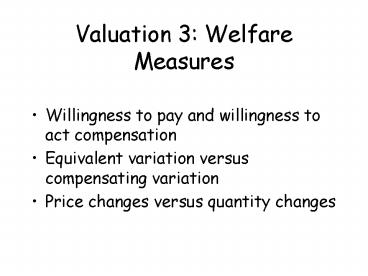Valuation 3: Welfare Measures - PowerPoint PPT Presentation
1 / 18
Title:
Valuation 3: Welfare Measures
Description:
Willingness to pay (WTP) to secure price fall is known as equivalent variation ... Ergo, E=C. Zero Substitutability. The direct utility ... – PowerPoint PPT presentation
Number of Views:139
Avg rating:3.0/5.0
Title: Valuation 3: Welfare Measures
1
Valuation 3 Welfare Measures
- Willingness to pay and willingness to act
compensation - Equivalent variation versus compensating
variation - Price changes versus quantity changes
2
WTP and WTAC
- Consider price fall P ? P
- Willingness to pay (WTP) to secure price fall is
known as equivalent variation - Willingness to accept compensation (WTAC) to
forego price fall is known as compensating
variation - WTP lt WTAC, because of income effect
3
WTP and WTAC -2
- There are gains and loss, so four measures
- WTP to secure a gain
- WTAC to forego a gain
- WTP to prevent a loss
- WTAC to tolerate a loss
- People view gains and losses differently
- Confirmed by empirical studies, but not
uncontested - Implies that surveys, policies need to be
carefully designed
4
Welfare Measures
- Compensating variation is the quantity of income
that compensates consumers for a price change,
that is, returns them to their original welfare - Equivalent variation is an income change that
yields the same utility change as the price
change
5
Welfare Measures -2
- In case of quantity changes, compensating and
equivalent variation are defined as - U0 results from (p,q0,y). If q0 increases to q1,
income has to be reduced by CV/p to keep the same
utility
6
Welfare Measures -3
- This need not hold for quantity changes.
- The reason is that the curvature of the utility
function can, in principle, increase or decrease
at higher levels of utility - In practice, however, environmental goods are
relatively scarcer than market commodities, so
that one may expect the compensating variation to
be smaller than the equivalent variation
7
Two Polar Cases
- An individuals utility u depends on the
consumption of x and a fixed quantity q - This yields ordinary demand functions h and an
indirect utility function v - An alternative way of defining compensating and
equivalent variation is
8
Perfect Substitution
- The direct utility
- This yields indirect utility function
- Compensating, equivalent variation (p11)
- Ergo, EC
9
Zero Substitutability
- The direct utility
- There are areas where q is constraining the
agent would be willing to pay a finite amount to
get more q and less x - However, no amount of additional x would
compensate for a loss of q - Here, equivalent variation is infinitely larger
than compensating variation - This suggests that substitution is key
10
A More General Case
- An individuals utility u depends on the
consumption of x and a fixed quantity q - The dual yields the inverse compensated demand
curve - And an expenditure function
11
A More General Case -2
- Which implies
- Compensating, equivalent variation
12
WTP v WTAC
- Compensating, equivalent variation
- Thus, EgtC (EltC) for a normal (inferior) good
- Note, Hanemann switched signs, so CVgtEV
13
A More General Case -3
- In the optimum
- Define a consumper surplus
- And an income elasticity
14
A More General Case -4
- Some trickery and approximation
- However,
- Where ? is the income elasticity of ordinary
demand, ? is the budget share of q, ? is the
own-price elasticity of compensated demand, and ?
is the substitution elasticity of q
15
A More General Case -5
- If ?0 (no income effect), or if ??, EAC
- If, on the other hand, income elasticity is high,
or there few substitutes for q, then ? can vary
substantially, even over small ranges of q
16
Theory and Practice
- Horowitz and McConnell collect 208 observations
of WTP and WTAC from 45 studies - For all studies, the average ratio WTAC/WTP is
7.2 (0.9) - However, for public or non-market goods, the
ratio is 10.4 (2.5) - For ordinary goods, it is 2.9 (0.3)
- For money, it is 2.1 (0.2)
- This is not inconsistent with theory
17
WTP v WTAC
18
Welfare Measures 4 (out)
- Compensating variation is defined as
- This is the same as
- If x is a weak compliment to q, and is the
choke price, E 0.































